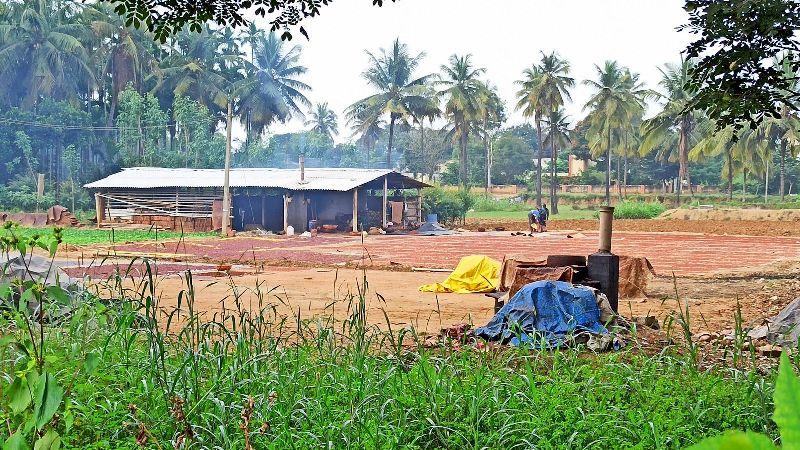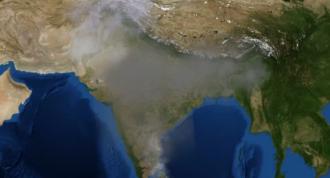
Photo by Sudhira HS
New research shows that rural and urban regions of India face similarly high health risks due to air pollution.
Rural India’s air pollution problem needs more attention. Air pollution, the leading cause for premature deaths in the world, is portrayed in mainstream media as a grave health crisis for urban areas of India. Every year, cities like Delhi and Lucknow make headlines as the most-polluted regions and are the focus of government initiatives such as the National Clean Air Programme. However, a new study shows that people in non-urban parts of India — constituting 70% of the country’s population — are exposed to air pollution levels which are on par with urban areas.
The researchers from Colorado State University (CSU), USA and Indian Institute of Technology Bombay (IIT Bombay), while working on evaluating the levels of air pollution across the country, realised that there is an urgent need to study its impact on people residing in non-urban areas. The study was partly funded by grants from National Aeronautics and Space Administration and was published last week in the journal Proceedings of the National Academy of Sciences.
Previous research had found that deaths due to exposure to polluted air containing PM2.5 — hazardous particles finer than 2.5 microns in diameter — and ozone were three times as much in rural areas as urban areas. The study used air pollution data measured across North India over four months. “We wished to definitively evaluate non-urban versus urban impacts of air pollution through the use of all-India data at high spatial resolution (~4.5 km) for a whole year,” says Prof Chandra Venkataraman from IIT Bombay, one of the researchers involved in the study, about the motivation behind the current work.
Indian cities are imagined as places that throng with a large number of people. But, many non-urban areas, especially in northern India, have a huge population density. The study estimates that around 40 crore people live in urban areas while the number is close to 70 crores in rural regions.
“We went to some lengths to address the issue of urban versus non-urban because the population densities are not as different between the two, as one would imagine from looking at North America, Europe, or South America. The lack of a massive difference in population density between urban and non-urban regions may be a feature of the developing world,” explains Prof A.R. Ravishankara from CSU, who was part of this study. Yet, most research studying air pollution in India focuses on its impact on cities.
The researchers calculated the amount of PM2.5 present across India at the ground surface from satellite measurements of aerosols. They did not find much difference in air pollution levels between urban and rural regions at different parts of the country.
The Indo-Gangetic Plain, which includes the belt of states stretching from Punjab to West Bengal, has the highest levels of air pollution. It is also the most densely populated region in India. Here, the pollution is almost evenly spread across urban and non-urban areas, report the researchers.
While the rest of India shows lower levels of air pollution, the air quality is still much worse than India’s national standard; more than 80% of the people are breathing polluted air. Moreover, India’s limit for healthy air is set four times over that of the WHO’s standards; thus, almost all of the country lives with air quality a lot poorer than levels considered safe by WHO.
The researchers also estimated that an excess 10.5 lakh people experience early death owing to heart and lung diseases every year caused by exposure to PM2.5. Out of this, 69% of the deaths are in non-urban areas — that is, an excess 7 lakh people experience early death annually due to air pollution in rural areas. In general, while the sources of air pollution vary, with almost similarly elevated levels of PM2.5 levels in urban and rural regions, both groups of the population face comparable health risks.
“I hope that our study, along with a few others that have broached this topic, will first allow people, policymakers, and managers to recognise the need for air quality considerations in the non-urban regions. Recognising the problem is the first step; an essential one. Once non-urban pollution is recognised, the subsequent measures to mitigate and change the situation can be taken up,” says Prof Ravishankara.
Although sources of air pollution such as vehicular emissions, industries and stubble burning in farms receive attention in policy recommendations, there is a need to monitor and control other sources too. “We find that residential cooking in chulhas with biomass fuels (wood, crop residue and dung cakes) is the single largest source impacting outdoor air pollution in India,” says Prof Venkataraman. “These sources, as well as traditional brick production and waste burning, must urgently be brought within the purview of air pollution mitigation.” She proposes that the National Clean Air Programme should bring in a “regional” component in addition to its current urban focus.
“The largest challenge in estimating air quality from the ground is the lack of sufficient monitoring stations,” says Prof Ravishankara. Non-urban India, which faces a high risk of health problems and death, hardly has any monitoring setups, which is needed to inform and steer policy decisions. “This is one area where India could significantly enhance its capability,” he adds.
“We are working on developing monitoring projects, which should further our understanding on “non-urban” or regional air pollution, a key to providing effective solutions to our air pollution problem,” says Prof Venkataraman.
“Currently, the exceptionally high pollution levels of big cities are in the news, and the equally important non-urban areas are neglected. After all, a majority of the people in India live in non-urban areas,” Prof Ravishankara signs off.






